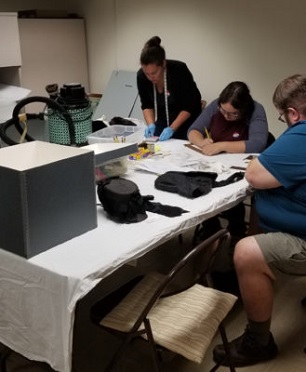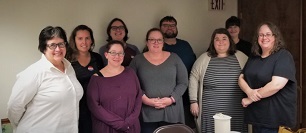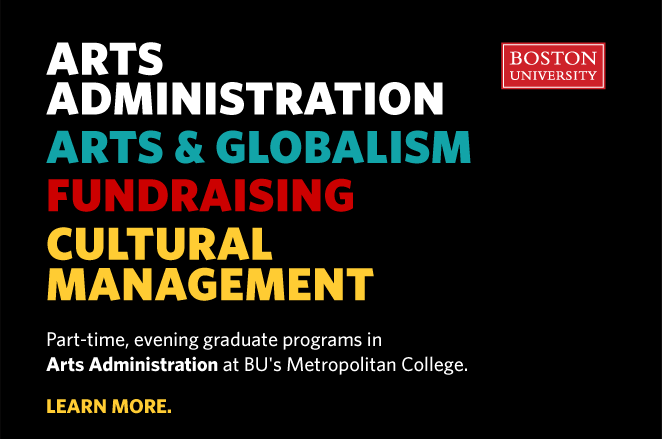Museum Super Heroes: NEMA 2018 Day of Service
By Meredith Vasta, Collections Steward, Peabody Museum of Archaeology and Ethnology, Harvard University and Co-chair of the Registrars and Collections Care Specialists Professional Affinity Group
Museum collections are in danger. The 2011 ICCROM-UNESCO International Storage Survey found that many museums worldwide lack proper storage space for their collections and that 40% of surveyed museums may not even know what they hold. Often, there is not the support, staff, or time to keep up best practices in collections management. Luckily, museums employ a wide range of super heroes who protect collections. And when we aren’t doing it at our home institutions, we help others create organization out of chaos. Because we dedicate our careers to preserving these artifacts, we set the stage to meet our institutions’ educational goals so we can have conversations with the public about where the objects come from, who treasured them, and the role they played in our shared history.
Our regional museum association, the New England Museum Association, includes several Professional Affinity Groups including the Registrars and Collections Care Specialists (RACCs). In light of the Storage Survey and following the lead of other professional organizations (Association of Registrars and Collections Specialists, American Alliance of Museum’s (AAM) Collections Stewardship Committee, and Registrar Committee, Western Region), we decided to organize a day of service before our annual conference held in Stamford, Connecticut, November 7-9, 2018. We had never done this before but felt it was an important way to support our colleagues and share our skills.
With NEMA’s support, Sara Frankel, collections manager at The Collection of Historical Scientific Instruments, Harvard University, and Sira Dooley Fairchild, formerly the collections manager at the Bostonian Society, offered to lead this new initiative. A year before the conference, they contacted the other organizations who regularly do this type of program and learned what works and what doesn’t. These organizations shared their application forms for volunteers and host sites, project timelines, and more. We learned to meet in-person with the host institution before the event to clarify the project, see the work space, get a sense of the anticipated work flow, and talk about logistics such as the number of worktables available, parking, and lunch options.
To identify a museum to work with, we located institutions within one hour of our conference location and invited them to apply for our proposed volunteer collections management assistance. We wanted to encourage as many applications as possible. We asked applicants to tell us a little bit about their institution, to explain the project we could help them with, and to outline the resources they thought they would need for that project.
We received three worthy applications and, after much consideration, we chose the Shelton History Center in Shelton, Connecticut, a small non-profit owned and operated by the Shelton Historical Society, with three part-time staff members and a handful of regular volunteers caring for five historic buildings, archival materials, photographs, and historic artifacts. Their object collection numbers around 5,000 and is in need of basic inventorying and cataloging. To improve intellectual and physical control over the collection, we planned to assign unique accession numbers, take photos with our smart phones, write brief object descriptions, take measurements, and note condition issues.
To prepare, two months before the November meeting, Sira, Sara, and I drove down to Shelton and met with Deborah G. Rossi, the curator, and Tracey Tate, the director. As a group, we hammered out the project details and put together a supply list. We knew a big inventory project would require supplies such as acid-free tags, nitrile gloves, acid-free tissue, and archival boxes. University Products and MasterPak generously donated materials on our supply list. We also created forms to capture a brief object description, measurements, and condition issues. Shelton staff and volunteers could continue to them for future collection management needs once we left.
We were prepared, but a water emergency nearly derailed the project. One month before the event, the Shelton History Center’s sump pump had failed after a heavy rain, flooding the work room. Supporting the notion that museums are staffed with super heroes, Shelton staff organized the renovation that space in the four weeks before our volunteer day. In the end, we did not have to change the project from inventory to disaster recovery. But this incident reminded us of the importance of disaster preparedness and that sometimes we need to adapt at the last minute.
Host site with a project? Check. Supplies to get the job done? Check. Now, we needed volunteers. I announced this project at the 2017 NEMA conference, NEMA added the event to the conference website about six months before the conference, and we sent out a call for volunteers through our Facebook page a couple of months before the event. Our community did not disappoint. Ten people volunteered to help the Shelton History Center.

Three of our volunteers cataloging some of the wide variety of Shelton’s collections—everything from a Shelton-made vacuum to historical women’s clothing and hats.
By unleashing collections professionals for a day, we cataloged and photographed 175 objects in the collection—everything from colonial agricultural tools to vintage vacuum cleaners. As the forms were completed, Sara collected them and put all the information in an Excel spreadsheet and set up a Dropbox for everyone to put their images in. At the end of the day, the Shelton History Center had a spreadsheet and images of previously uncatalogued collections. Having clear records and inventory control on the collections make them accessible to the community, researchers, and others. It isn’t the most glamourous work, but it is critical to the preservation of our material culture.
At the end of the day, we didn’t want to leave. We even thought about not going to the conference and instead, going back the next day to help some more. Museum collections may be in danger. Yet this project shows that collaborating with others can go a long way to improve collections care. Now that the conference is over, we started planning for next year’s volunteer project in Burlington, Vermont. Get ready! There are some eager collections professionals ready to help in whatever basement, attic, or other storage facility that needs us. We hope to see you there!
Have we inspired you to develop a similar project for your own organization? Has your professional public history organization done a similar volunteer outreach project? Tell us about it in the comments!

Front Row (left to right): Tracey Tate, Sara Frankel, Camille Breeze, Leah Rafaela Cereillo, Deborah G. Rossi. Back Row: Diane Lee, Mell Scalzi, Daniel Neff, Morgan Blei Carbone
This article was originally posted on the National Council on Public History's blog History@Work.
